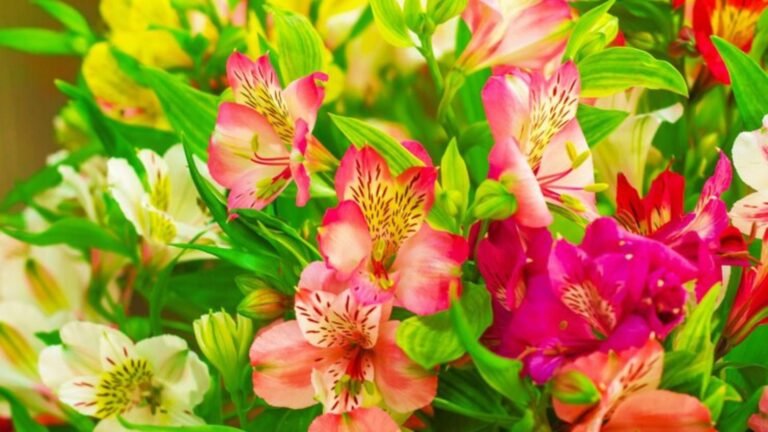Astromelias, also known as Alstroemeria or Peruvian lily, are stunning perennial flowers that add a splash of color and elegance to any garden. With their vibrant hues, long-lasting blooms, and versatile growth habits, these flowers have gained popularity among gardening enthusiasts and floral designers alike. In this article, we will explore the characteristics of Astromelias, their care requirements, propagation methods, and more.
What Are Astromelias?
Astromelias belong to the Alstroemeriaceae family and are native to South America, particularly in regions like Chile and Brazil. The genus name Alstroemeria honors the Swedish botanist Clas Alströmer, who introduced the plant to Europe in the 18th century. These perennials are known for their beautiful, trumpet-shaped flowers, which come in a wide range of colors, including pink, orange, purple, yellow, and white.
Characteristics of Astromelias
Astromelias typically exhibit the following features:
Flower Structure: Each flower consists of six petal-like tepals, often decorated with dark spots or stripes, which attract pollinators such as bees and butterflies.
Height: Depending on the variety, Astromelias can grow anywhere from 12 to 48 inches tall, making them suitable for various garden settings.
Foliage: The plants have slender, lance-shaped leaves that are green and glossy, providing a lovely backdrop for their striking blooms.
Blooming Season: They bloom from late spring to early fall, ensuring a long display of color throughout the growing season.
Growing Astromelias
Ideal Growing Conditions
To successfully grow Astromelias, it’s essential to provide them with the right growing conditions:
Sunlight: These flowers thrive in full sun to partial shade. Ideally, they should receive at least 6 hours of direct sunlight daily.
Soil: Well-draining soil rich in organic matter is crucial. A slightly acidic to neutral pH (6.0 to 7.0) is preferred.
Watering: While Astromelias are relatively drought-tolerant once established, they require consistent moisture during the growing season. Avoid waterlogging, as this can lead to root rot.
Planting Astromelias
Choosing a Location: Select a sunny spot with well-draining soil.
Soil Preparation: Amend the soil with compost to improve its structure and nutrient content.
Planting: Dig holes that are twice the size of the root ball and plant the tubers or seedlings, ensuring the crowns are level with the soil surface.
Spacing: Space plants about 18 to 24 inches apart to allow for their mature spread.
Care and Maintenance
Fertilization: Use a balanced fertilizer in early spring and again mid-summer to promote healthy growth and blooming.
Mulching: Apply a layer of organic mulch to retain soil moisture and suppress weeds.
Deadheading: Regularly remove spent blooms to encourage further flowering and maintain the plant’s appearance.
Propagating Astromelias
Astromelias can be propagated through division or by planting seeds.
Division
Timing: The best time to divide Astromelias is in early spring or fall when the plant is not actively growing.
Process: Carefully dig up the clumps and separate the tubers, ensuring each division has healthy roots. Replant them immediately.
Seed Propagation
Collecting Seeds: After flowering, allow the seed pods to mature before harvesting them.
Sowing: Sow seeds indoors in seed-starting trays about 8-10 weeks before the last frost. Transplant seedlings outdoors once they are strong enough and the threat of frost has passed.
Pests and Diseases
While Astromelias’s are generally resilient, they can be susceptible to certain pests and diseases.
Common Pests
Aphids: These small insects can weaken the plants by sucking sap. They can be controlled with insecticidal soap or neem oil.
Spider Mites: These tiny pests thrive in dry conditions. Increasing humidity can help control their populations.
Diseases
Root Rot: Caused by overwatering and poor drainage, root rot can be prevented by ensuring good soil drainage.
Botrytis Blight: This fungal disease affects the leaves and flowers, causing them to appear gray and mushy. Proper air circulation and avoiding overhead watering can help prevent this issue.
Astromelias in Floral Arrangements
Astromelias are popular choices for cut flowers due to their long vase life and striking appearance. Their versatility allows them to complement various floral designs, from bouquets to centerpieces.
Tips for Using Astromelias in Arrangements
Harvesting: Cut the stems in the early morning when temperatures are cool for the best results.
Conditioning: Place the cut stems in water immediately and allow them to hydrate for several hours before arranging.
Pairing: Astromelias’s pair well with other flowers like roses, lilies, and greenery, creating vibrant and harmonious arrangements.
Conclusion
Astromelias’s are an excellent addition to any garden or floral arrangement, offering beauty, color, and versatility. With their easy care requirements and stunning blooms, these flowers are perfect for both novice and experienced gardeners. Whether you’re looking to enhance your garden landscape or create breathtaking floral displays, Astromelias’s are sure to impress.
ALSO READ:Everything Everything Book: A Comprehensive Guide
FAQs
How do I care for Astromelias in winter?
Astromelias are hardy in USDA zones 8-10. In colder climates, mulch around the base to protect the roots. You can also dig up the tubers and store them in a cool, dry place.
Can Astromelias be grown in containers?
Yes, Astromelias can be grown in containers. Choose a pot with good drainage and use high-quality potting soil. Ensure they receive adequate sunlight and water.
How often should I water Astromelias?
Water them regularly, especially during dry spells. Once established, they are relatively drought-tolerant, but consistent moisture is essential for optimal blooming.
Are Astromelias deer-resistant?
While no plant is entirely deer-proof, Astromelias are generally considered deer-resistant due to their mild toxicity.
When do Astromelias bloom?
Astromelias typically bloom from late spring through early fall, providing a long-lasting display of vibrant flowers throughout the growing season.

